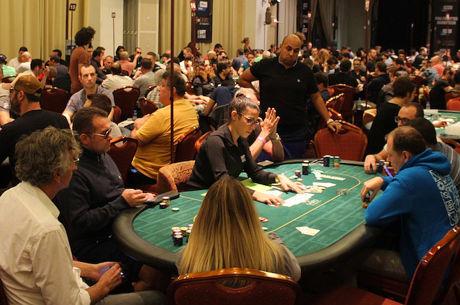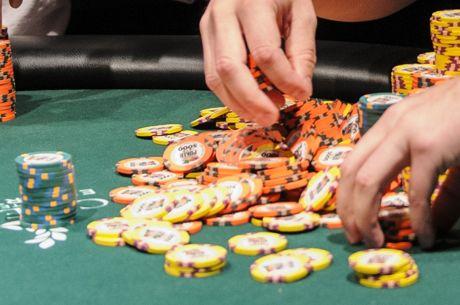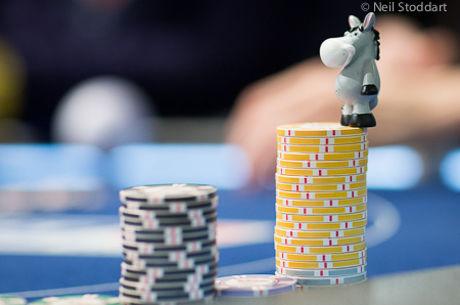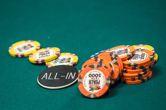A Multiple Semi-Bluff Opportunity in a Las Vegas $1/$2 Game
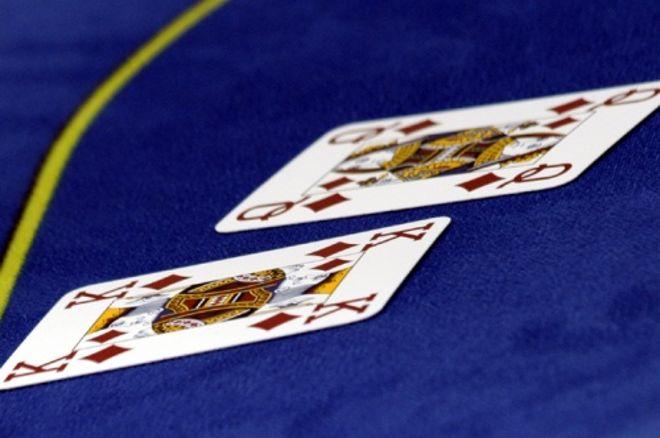
An interesting hand analysis was presented by Bob Bohme at a recent Wednesday Poker Discussion Group meeting in Las Vegas. He made extensive use of Flopzilla to determine whether or not a semi-bluff shove on the turn was the strongest play.
Bob's analysis was well done, but it occurred to me that our analysis might be different depending on what assumptions we make for the villain's range at different points in the hand. What if we are wrong about our "read" of the type of villain or hand range we are facing?
Let's see what happens when we make reasonable modifications to our baseline assumptions.
Preflop
Our Hero (Bob) had been playing at this $1/$2 table at Caesars for a couple of hours when his hand comes up. The villain in the hand appears to be a solid position-aware player who has already twice folded his preflop raise to a three-bet.
Mr. Solid opens for $12 in the hijack. Hero is next to act in the cutoff seat with K?Q? and the stacks are $200 effective.
Hero believes that Villain would raise with a wide 20 percent of his hands in this situation and would fold to a three-bet about half of the time. Should he fold, call or three-bet in this situation?
It's interesting that most of the audience at the WPDG said they would fold this hand against a typical $1/$2 player who only raises about 6 percent of the time. Meanwhile some said they would call against this particular villain, but few would three-bet him in this situation.
Flopzilla ranks K?Q? as a top 3.5 percent hand, though I rank it a somewhat weaker 6 percent hand in my Donkey Poker starting hands chart. Either way, it is generally very playable, especially when we have a strong table position.
Flopzilla shows we have 51 percent showdown equity against a standard 20 percent range. If everyone else folds, and raking away $2, we would be effectively calling $12 into a $13 pot. So we are getting 12 / 25 = 48 percent pot odds with 51 percent equity. This seems like a coin flip until we consider the enhanced profit we can make using our superior position and skill. Folding would be a weak play here.
What if the villain is a much weaker player? The average Vegas preflop raise frequency (PFR) is only 6 percent, which would provide us only 36 percent showdown equity! A call might still be profitable due to the strong value of our position and skill. Additional callers could improve our expected value, but that also complicates matters since we are not guaranteed to have postflop position. A call against this player might be marginal without additional knowledge about this player.
What about a three-bet bluff against Mr. Solid? I say "bluff" because since we are unlikely to be ahead of his three-bet calling range, a three-bet should be considered a bluff.
Since KQs has a 5.9 percent chance of flopping two pair or better, a 10.9 percent of flopping a flush draw, and 3.9 percent chance of flopping an open-ender, a three-bet could also be considered a semi-bluff. (Note that KQs is not the same as lower suited connectors since it only has two ways to flop a straight!)
If Villain folds half of his range, we have 50 percent fold equity (FE) and 42 percent Flopzilla showdown Equity When Called (EWC) against his remaining 10 percent range. Hero raised to $35 in the actual hand, so his Momentary EV would be:
MEV10 = 0.5($15) + 0.5[(0.42)($73 - $5) - $35] = +$4.28
So half the time we win the current $15 pot. The rest of the time we win 42 percent of the $68 pot, less our investment. (We can check our math by assuming we have zero equity when called. Then we would win $15 half of the time and lose $35 half of the time, for a $10 net loss.)
Notice that as our FE goes up, our EWC will go down. So the second term in the equation is somewhat insensitive to reasonable choices for fold equity. We don't have to be particularly precise here to determine that MEV10 is easily positive.
If Mr. Solid always four-bets with AA and KK, and if we always fold, he will only be four-betting 0.9 / 20 = 4.5 percent of the time, which only reduces our MEV to about $4.07, so we need not worry much about being four-bet for value. On the other hand, our Hand EV should be enhanced by our superior position and ability to leverage our profit when we flop well.
It appears, then, that three-betting in this situation is more profitable than calling, and as it happened Hero did three-bet to $35. (Note: this analysis does not claim that $35 is the optimal three-bet size. That analysis would require Hero to estimate Mr. Solid's elasticity to Hero's bet sizing.)
But what if our estimate of Villain's three-bet calling range is way off, as we hinted above? If he only calls with a 5 percent range, our FE = 75 percent, our EWC = 34 percent, and our MEV5 = $8.28. So, if he folds too much, our momentary expected profit is even greater.
We can also do this analysis for a more passive villain with only a 6 percent preflop raising range. If he also folds half of his range to the three-bet, our FE = 50 percent, EWC = 29 percent and our MEVpassive = -$0.19!
That would mean this sort of player is more dangerous to three-bet, depending on his actual raising and three-bet calling ranges. But our prospects are still positive due to our superior positon and postflop skill. Only when our villain is extremely passive should we consider folding to his preflop raise.
(Worth adding: MEVpassive = $0.00 for a $4 rake and -$0.29 for a $6 rake, so this bet is less profitable at Caesars than at the Red Rock. It's important to include the rake in our calculations when the decision is close.)
The Flop
Mr. Solid calls our three-bet and we see a heads-up flop of 4?4?J?. The pot is $68 and Mr. Solid checks. Should Hero check behind or continuation bet? Surprisingly, many in our WPDG audience said they preferred to check behind.
Hero estimated Mr. Solid would fold 50 percent of his opening range to a preflop three-bet. But we can also discount his aces and kings to some extent since most $1/$2 players would four-bet with them. (These players rarely consider stack sizes here.)
Let's assume they would four-bet aces or kings half of the time. (The analysis reaches the same conclusion whichever assumption we make.) This provides Villain with 98.5 combos, of which 29.5 are top pair or better. If we assume that Villain will only call with top pair or better, our FE = 69 / 98.5 = 70 percent and our EWC = 20 percent. If Hero c-bets $35, his MEV = $41.18!
Even if we assume Mr. Solid will call a c-bet with half of his range, adding perhaps some underpairs and ace-king hands, our c-bet is still clearly very profitable, with MEV = $23.98. Clearly, our range assumptions don't have to be very precise here.
Even when the villain's preflop three-bet calling range is very tight (say 3 percent), he will still only have 15 out of 30 combos that are a pair or better. So a half-pot bet would still be profitable since such a c-bet only needs 33 percent fold equity even if our EWC is zero.
The question then becomes, can we make more profit by simply checking behind? There is $68 in the pot and our showdown equity against Mr. Solid's range is 25 percent. So if we check, our share of the existing pot is $17.25. This is much less that our MEV of $41 for c-betting. A semi-bluff c-bet seems to be automatic in this situation unless a live read suggests otherwise.
The Turn
After Hero c-bets $35 on the flop, Mr. Solid calls again. The pot is now $138 with effective stacks of $140. The turn is the 10?, for a board of 4?4?J?10?, and Mr. Solid checks again. Should we check or bet? Now most of the WPDG audience thought betting is best.
At this point we have a dangerous board, with both flush and straight draws. Let's assume that Mr. Solid has called the flop c-bet with half of his range. Very few Las Vegas $1/$2 players would check again on the turn if they had a full house, so TT and JJ can now be heavily discounted. (Let's discount them to 1 combo each.) So he now has only 39 combos, of which 11 combos are an overpair or better. Another 16 combos are top pair, 12 of them with an ace-kicker.
Suppose we check. We have 36 percent equity in this pot, so our fair share would be $49.68. But when we river our straight or flush, we should be able to make some additional profit, on average. Or, on a blank river, we may be able to take the pot down with a bluff when the villain checks to us. So our average profit in the hand should be more than $50.
Suppose we shove and Mr. Solid folds everything but an overpair or better (11 combos). Our fold equity would be FE = 28 / 39 = 72 percent, EWC = 31 percent, and our Hand EV = $84.29. This is clearly better than our expected profit if we just check behind.
Or, we could assume that the Villain also calls our shove with top pair, top kicker, which would be another 12 combos. Now our fold equity is only 16 / 39 = 41 percent, EWC = 37 percent, and our Hand EV = $34.67. So our profit depends strongly on our expected fold equity. Our EWC increases when our FE decreases, but not by enough to counterbalance our lower FE. Checking behind might be more profitable against this type of villain, especially since any villain who will call a turn shove so widely is also more likely to pay us off on a good river card.
Another option we have is to bet merely half-pot, or about $70. But since the purpose of our bet is to semi-bluff with our very strong draw, we actually hope to get a fold. (Fold equity is the most important factor for a semi-bluff.) And we put ourselves into a tricky situation if the villain shoves on us.
Our turn decision depends on the type of player we are facing. If he will not make a loose call, a shove is clearly superior. After all, he has to be worrying that we have aces, kings, or jacks here.
Conclusion
We have a situation where we can reasonably semi-bluff preflop, on the flop, and on the turn. We can run through our analysis using our best assumptions about what the Villain's various ranges are. This seems to give very straightforward answers, as long as we are correct in our assumptions.
But a better approach is to bracket our assumptions and use Flopzilla to run a branching analysis of our results. We will usually find that moderate variations make very little impact on our decisions. Eventually we realize that we don't have to be especially refined in our assumptions in real time at the table.
The Grinders Cup
The 2018 Grinders Cup will kick off the week of March 5 in the Mirage poker room in Las Vegas. You can check out the particulars on the Grinders Cup website.
This is a four day $1/$2 NLH cash game tournament, consisting of 24 hours of cash game play with no rake, no tips, and no escalating blinds. It should be a blast.
Steve Selbrede has been playing poker for 20 years and writing about it since 2012. He is the author of five books, The Statistics of Poker, Beat the Donks, Donkey Poker Volume 1: Preflop, Donkey Poker Volume 2: Postflop, and Donkey Poker Volume 3: Hand Reading.

